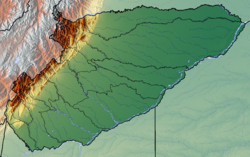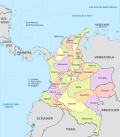Casanare Department
Department of Casanare
Departamento de Casanare | |
|---|---|
 Coat of arms | |
| Motto(s): Trabajo y Libertad (Spanish: Work and Freedom) | |
| Anthem: Himno de Casanare | |
 Casanare shown in red | |
 Topography of the department | |
| Coordinates: 5°21′0″N 72°24′36″W / 5.35000°N 72.41000°WCoordinates: 5°21′0″N 72°24′36″W / 5.35000°N 72.41000°W | |
| Country | |
| Region | Orinoquía Region |
| Established | July 4, 1991 |
| Capital | Yopal |
| Government | |
| • Governor | Salomon Andres Sanabria (2020-2023) |
| Area | |
| • Total | 44,640 km2 (17,240 sq mi) |
| Area rank | 10th |
| Elevation | 350 m (1,150 ft) |
| Population (2018)[1] | |
| • Total | 420,504 |
| • Rank | 25th |
| • Density | 9.4/km2 (24/sq mi) |
| Time zone | UTC-05 |
| ISO 3166 code | CO-CAS |
| Municipalities | 19 |
| HDI (2017) | 0.731[2] high · 16th |
| Website | www.casanare.gov.co |
Casanare Department (Spanish pronunciation: [kasaˈnaɾe], Spanish: Departamento de Casanare) is a department in the central eastern region of Colombia.
Its capital is Yopal, which is also the episcopal seat of the Roman Catholic Diocese of Yopal.
It contains oil fields and an 800 km pipeline leading to the coastal port of Coveñas owned by BP.
Rivers and dams[]
The Upía River (Río Upía) is in Casanare.[3]
History[]
| Year | Pop. | ±% |
|---|---|---|
| 1973 | - | — |
| 1985 | 147,472 | — |
| 1993 | 211,329 | +43.3% |
| 2005 | 295,353 | +39.8% |
| 2018 | 420,504 | +42.4% |
| Source:[4] | ||
A former subregion of Boyacá, Casanare became separate department in 1973.
Municipalities[]
- Aguazul
- Chámeza
- Hato Corozal
- La Salina
- Maní
- Monterrey
- Nunchía
- Orocué
- Paz de Ariporo
- Pore
- Recetor
- Sabanalarga
- Sácama
- San Luis de Palenque
- Támara
- Tauramena
- Trinidad
- Villanueva
- Yopal, capital
See also[]
References[]
- ^ "DANE". Archived from the original on November 13, 2009. Retrieved February 13, 2013.
- ^ "Sub-national HDI - Area Database - Global Data Lab". hdi.globaldatalab.org. Retrieved 2018-09-13.
- ^ "Archived copy" (PDF). Archived from the original (PDF) on 2009-03-27. Retrieved 2008-09-16.CS1 maint: archived copy as title (link)
- ^ "Reloj de Población". DANE. Departamento Administrativo Nacional de Estadísitica. Retrieved 6 July 2017.
Sources and external links[]
- (in Spanish) Government of Casanare official website
Categories:
- Casanare Department
- Departments of Colombia
- States and territories established in 1991
- Orinoquía Region geography stubs


